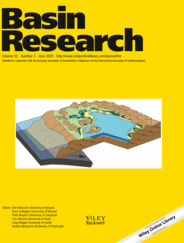
Full text loading...
The El Rito and Galisteo depocenters in north‐central New Mexico archive tectonically‐driven Paleogene drainage reorganization, the effects of which influenced sedimentation along the northwestern margin of the Gulf of Mexico. Although separated by ~100 km and lacking depositional chronology for the El Rito Formation, the two aforementioned New Mexican depocenters are commonly considered remnants of a single basin with coeval deposition and shared accommodation mechanism. Detrital zircon U‐Pb maximum depositional ages indicate that the El Rito and Galisteo formations are not coeval. Moreover, stratigraphic thickness trends and mapping relationships indicate different accommodation mechanisms for the Galisteo and El Rito depocenters; tectonically‐induced subsidence versus infilling of incised topography, respectively. The regional unconformity that bounds the base of both the El Rito and Galisteo formations is a correlative surface induced by local tectonic activity and associated drainage reorganization in the early Eocene, and was diachronously buried by northward onlap of fluvial sediments. Detrital zircon distributions in both depocenters indicate increased recycling of Mesozoic strata above the unconformity, but diverge upsection as topographic prominence of local basement‐involved uplifts waned. Sediment capture in these depocenters is coeval with deposition in other externally‐drained Laramide basins. Further, it corresponds to a period of low Laramide province‐derived sediment input and replacement by Appalachian‐sourced sediment along the northwestern margin of the Gulf of Mexico during a basin‐wide transgression. This illustrates the potential effect that pockets of sediment storage within the catchment of a transcontinental drainage system can have over the sedimentary record in the receiving marine basin.
,Stratigraphic architecture, lithofacies, provenance, detrital zircon mixture modeling, and paleocurrent analysis elucidate Paleogene tectonic activity and basin development in north‐central New Mexico. Depocenters from this area comprised a portion of the headwaters of a dynamic transcontinental river system that exerted a first order effect on sediment character and volume received by the northwestern margin of the Gulf of Mexico. During the middle Eocene depocenters in north‐central New Mexico captured Laramide province‐derived sediment, which starved the Gulf of Mexico of this detritus, and permitted westward incursion of Appalachian‐derived sediment.

Article metrics loading...

Full text loading...
References


Data & Media loading...

